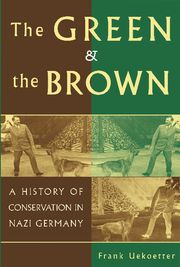Book contents
- Frontmatter
- Contents
- Acknowledgments
- Abbreviations
- A Note on Vocabulary
- 1 The Nazis and the Environment: A Relevant Topic?
- 2 Ideas: Diverse Roots and a Common Cause
- 3 Institutions: Working Toward the Führer
- 4 Conservation at Work: Four Case Studies
- 5 On the Paper Trail: The Everyday Business of Conservation
- 6 Changes in the Land
- 7 Continuity and Silence: Conservation after 1945
- 8 Lessons
- Appendix: Some Remarks on the Literature and Sources
- Selected Bibliography
- Index
Appendix: Some Remarks on the Literature and Sources
Published online by Cambridge University Press: 02 December 2009
- Frontmatter
- Contents
- Acknowledgments
- Abbreviations
- A Note on Vocabulary
- 1 The Nazis and the Environment: A Relevant Topic?
- 2 Ideas: Diverse Roots and a Common Cause
- 3 Institutions: Working Toward the Führer
- 4 Conservation at Work: Four Case Studies
- 5 On the Paper Trail: The Everyday Business of Conservation
- 6 Changes in the Land
- 7 Continuity and Silence: Conservation after 1945
- 8 Lessons
- Appendix: Some Remarks on the Literature and Sources
- Selected Bibliography
- Index
Summary
The history of conservation during the Nazi era is one of the better-researched topics in German environmental history, and some 25 years of scholarly activity have produced a considerable number of important books and a multitude of essays on a wide range of topics. It is not the intention of the following remarks to give a complete account of the range of publications or to provide in-depth descriptions of the major works: a comprehensive overview that the author wrote in 2002 filled thirty-five pages. The goal of this appendix is more modest in that it seeks to provide a rough overview on the most important books and articles as a guide to everyone who would like to read more. At the same time, it will give a more precise idea of the general direction in which this book seeks to push conservation history.
It is not surprising that the majority of publications have appeared in German, but a number of important contributions are in English. The most recent monograph is Thomas Lekan's Imagining the Nation in Nature, a book that draws strongly on Lekan's research on conservation work in the Rhineland from the late 1800s to 1945. The books of Alon Confino and Celia Applegate provide important insights into different aspects of German regionalism, whereas Raymond Dominick discussed the Nazi era extensively in his account of the German environmental movement.
- Type
- Chapter
- Information
- The Green and the BrownA History of Conservation in Nazi Germany, pp. 211 - 216Publisher: Cambridge University PressPrint publication year: 2006

